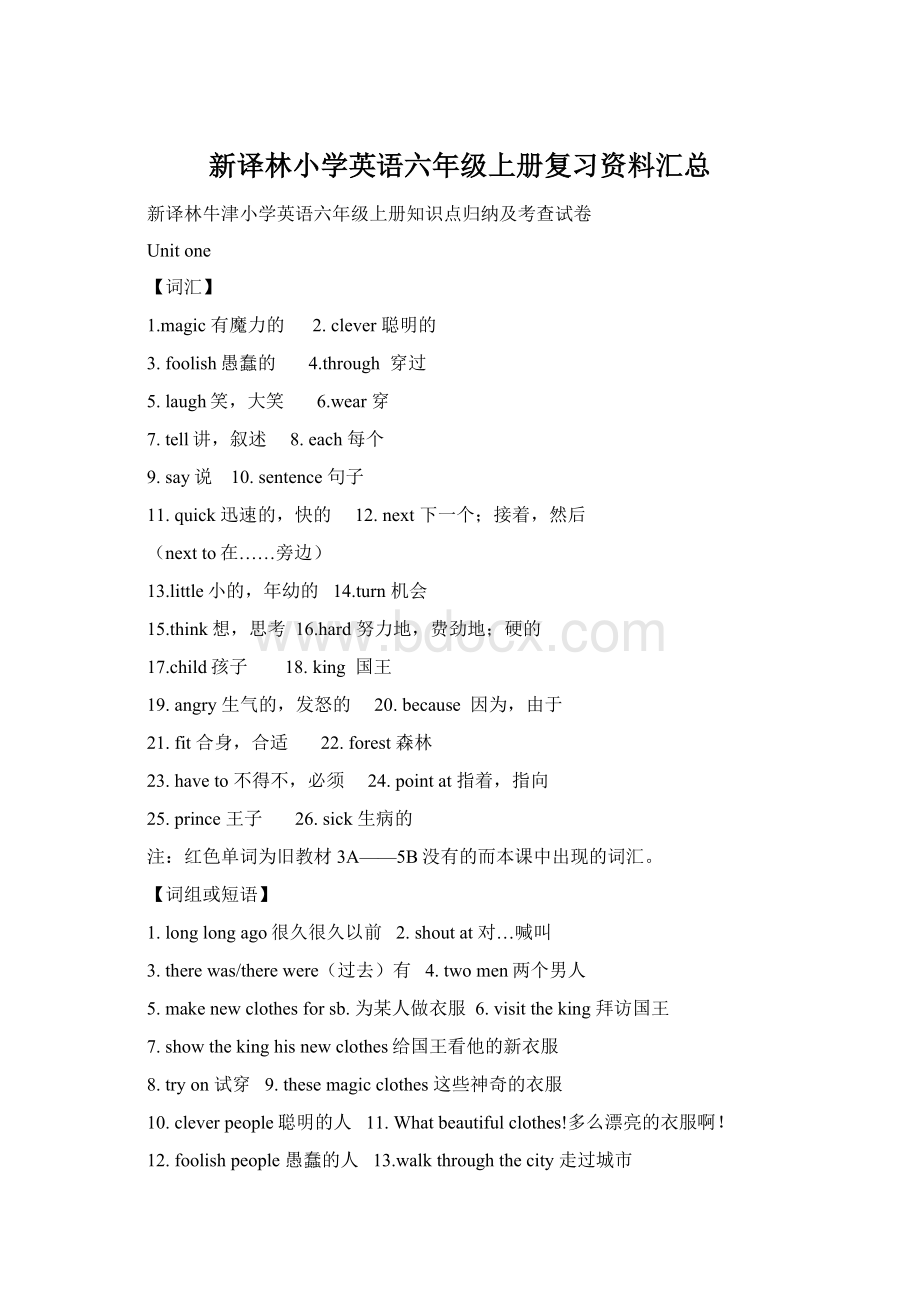新译林小学英语六年级上册复习资料汇总Word格式文档下载.docx
《新译林小学英语六年级上册复习资料汇总Word格式文档下载.docx》由会员分享,可在线阅读,更多相关《新译林小学英语六年级上册复习资料汇总Word格式文档下载.docx(73页珍藏版)》请在冰豆网上搜索。

16.inthestreet在街上17.lookattheking看着国王
18.pointat指着19.alittleboy一个小男生
20.pointattheking指着国王21.oneday有一天
22.laughathim笑他23.lookafter照顾
24.fitwell很合身25.cometomyparty来参加我的聚会
26.athalfpastfour在四点半27.eachstudent每个学生
28.sayone/asentence说一句话29.saythenextsentence说下一句
30.tell(sb)astory(给某人)讲故事31.besick生病
32.playagame玩游戏33.onthemountain在山上
34.It’sone’sturn.该轮到某人了。
35.thinkhard努力想
36.What’snext?
下一个是什么?
37.havetodo不得不做……
38.startthestory开始这个故事39.intheforest在森林里
40.infrontof在……前面41.anoldman一位老人
42.bythehouse在房子旁边43.pickaflower摘花
44.beangry生气45.givemeyourchild把你的孩子给我
46.benicetosb.对某人很好47.turnintoaprince变成一个王子
【语言知识点】
一、语法知识:
规则动词过去式的变化规律
Theylookedatthekingandshouted.他们看见国王并喊着。
Looked是look的过去式,shouted是shout的过去式。
像look,shout这样的规则动词变过去式的变化规律和发音规律如下:
变化规律:
(1)一般的动词原形后加-ed,如cookcooked,openopened等。
(2)以-e结尾的动词加-ed,如:
movemoved等
(3)以辅音字母加-y结尾的词,变y为i,再加-ed,如:
studystudied等
(4)以元音字母加-y结尾的词,直接加-ed,如:
playplayed,
Enjoyenjoyed等
(5)末尾只有一个辅音字母的重读闭音节词,双写该辅音字母,再加-ed,如:
stopstopped,planplanned等
发音规律
-ed在清辅音后发音为/t/,在浊辅音后发音为/d/,在元音后发音也为/d/,在/t/、/d/后发音为/id/。
be动词的过去式
be动词am,is的过去式为was;
are的过去式为were.例如:
Hewasverysadjustnow.他刚才很难过。
Wewereveryhungryamomentago.刚才我们非常饿。
建议:
教师要将三年级到六年级学过的规则动词给学生小结一下。
教学时,让学生在文章中找出包含有动词过去时的句子。
本单元出现的动词过去式:
visit—visitedshow—showedwalk—walkedlook—lookedshout—shouted
point—pointedlaugh—laughedwant—wantedpick—pickedturn—turned
like—likedlive—lived
二、语言知识点
1.long,longago,therewasaking.很久以前,有一个国王。
ago是副词,意思是“……以前”。
它指从此刻起若干时间以前,通常用于一般过去时中,如:
adayago一天前;
aweekago一星期前;
fiveminutesago五分钟前;
amomentago片刻以前等。
Long,longago的意思是“很久以前”,通常用于开始讲故事前,用于一般过去时中。
2.therebe结构的一般过去时的用法
Long,longago,therewasaking.
Therewas/were是therebe结构的过去式,表示的是“过去存在某人或某物”。
Therewas后面接可数名词单数形式或不可数名词,therewere后面接可数名词复数形式。
在therebe句型中,be动词的单复数由后面紧挨着的名词的单复数决定,即“就近原则”.l例如:
Therewasapenandsomebooksnearthecomputer.在电脑旁边有一支钢笔和一些书。
Thereweresomecrayonsandaknifeinmybag.我的包里有一些蜡笔和一把小刀。
(1)Therewas/were的否定句:
Therewas/were变成否定句,只要在was/were后面加“not”,其结构为“Therewas/werenot……”,可缩写为“therewasn’t/weren’t”.原句中有some,要把some改成any;
后面的名词前有a/an或any时,notany或nota/an可以转化为no.例如:
Therewasn’tanyteainhecuptenminutesago.十分钟以前杯子里没有一些茶。
Therewasnotabookonthetablethismorning.=Therewasnobookonthetablethismorning.今天早晨桌子上没有书。
(2)Therewas/were的一般疑问句:
Therewas/were的一般疑问句只需把was/were提到句首,若句子中有some,要把some改成any.肯定回答用“Yes,therewas/were”;
否定回答用“No,therewasn’t/weren’t”.例如:
-----wasthereabikeunderthetree?
树下有一辆自行车吗?
-----Yes,therewas.是的,有
-----Wasthereanyorangejuiceinthefridge?
冰箱里有些橘子汁吗?
-----No,therewasn’t.不,没有。
3.was和were的用法
Thekingwashappy.国王很高兴。
Was和were的意思都为“是”,was是am,is的过去式,were是are的过去式。
Was和were的否定形式分别为wasnot和werenot,可缩略为wasn’t和weren’t.例如:
I’mateachernow.ButIwasastudentoneyearago.
我现在是一个老师。
但是一年前我是一个学生。
Thereweren’tanytreesonthemountains.过去山上是没有树的。
4.tryon的用法
Myking,pleasetryonthesemagicclothes.我的国王,请试穿这些神奇的衣服。
tryon的意思是“试穿”,其后接名词时,名词可以放在on后面,也可以放在try和on的中间;
其后接代词时,代词只能放在try与on之间。
例如:
It’sabeautifuljacket.CanItryiton?
它是一件漂亮的夹克。
我能试一下吗?
5.what引导感叹句的用法
Whatbeautifulclothes!
多么漂亮的衣服!
这是一个由what引导的感叹句。
What修饰名词或名词短语,有以下两种结构:
“What+a/an(+形容词)+可数名词单数+主语+谓语!
”,例如:
Whatafinedayitis!
多么晴朗的一天!
“What(+形容词)+可数名词复数/不可数名词+主语+谓语!
Whatkindpeopletheyare!
多么友好的人们!
Whatnicemusicitis!
多么美妙的音乐!
●知识拓展how引导感叹句的用法:
How用来修饰形容词、副词,其结构是“how+形容词/副词+主语+谓语!
”。
Howclevertheboyis!
多么聪明的男孩!
Howhardtheworkersareworking!
工人们工作得多么勤劳!
Howquicklytheboyiswriting!
男孩写得多么快!
6.point的用法
Alittleboypointedatthekingandlaughed…一个小男孩指着国王并大笑着……
point的意思是“指”,作不及物动词时,可以和不同的介词构成短语,如:
pointat指着;
pointto指向;
pointout指出等。
Theboypointedatthebookandsaid,“it’smine.”那个男孩指着那本书说:
“它是我的书。
”
pointat与pointto
pointat习惯上表示指向离说话人较近的事物,意为“指着”,at是介词,着重于指的对象,指人时一般表示粗鲁或不礼貌。
Theteacherpointedattheblackboardandsaid,“youmustlookcarefully.”
老师指着黑板说:
“你必须仔细地看。
pointto多用来表示指向离说话人较远的事物,意为“指向”,to是介词,强调方向,并不是指着该物体。
Hepointedtothehouseontheothersideoftheriverandsaid,“that’smyhome.”他指向河对岸的房子说:
“那是我的家。
7.each的用法
Eachstudentsaysonesentence.每个学生说一句话。
Each后面接名词,表示“每个……”,谓语动词用单数形式。
Eachstudenthasapen.
Eachofthem后可接动词的单数或复数形式。
Eachofthemare/ishere.他们每个人都在这儿。
8.turn的用法
(1)It’sBobby’sturn.该轮到Bobby了。
turn
作名词,意为“轮流”“依次轮流的顺序”。
例如:
Now
it’s
your
to
read
the
text.
现在轮到你读课文了。
It'
s
my
use
bike.
该轮到我用自行车了。
(2)Heturnedintotheprince.他变成了王子。
Turn作动词,意为“转变”,“变成”。
into变成
Water
turns
into
ice.
水变成了冰。
...
(使……)成为……
The
farmers
are
turning
waste
land
rice
fields.
农民们把荒地变成了稻田。
9.by的用法
(1)by+地点名词。
表方位,意为:
“在…旁边”。
如:
bythelake/river/tree/window/door等。
Aboyissittingbythelake.有个男孩正坐在湖边。
有时可表:
“从…旁经过”,多与动词go/walk/pass等连用。
Oneday,anoldmanwalkedbythehouse.有一天,一个老人从房子旁边走过。
(2)by+交通工具、交通方式名词时,名词前不加冠词,且名词不变复数,意为“通过;
由;
乘”,如:
bytrain等。
Heusuallygoestherebybus.他通常是坐公交车去那里的。
Whynotgobytrain?
为什么不坐火车去?
【语音】
ar/ɑ:
/与汉语“啊”相似,但下巴要放低一点。
口腔打开,嘴张大,舌身放平自然放松,舌尖抵下齿,放松发音。
car,star,park,market,March,card,farm,garden,large,party,arm,card,hard…
UnitOne单元练习卷
班级____________姓名_______________得分________________
听力部分(30分)
一、听录音,选出你所听到的单词。
(共10小题;
每小题1分,满分10分。
每小题读两遍)
()1.A.mountainB.mouthC.house
()2.A.wasB.wereC.are
()3.A.hardB.halfC.hand
()4.A.cleverB.elevenC.seven
()5.A.likedB.lookedC.lived
()6.A.startB.storyC.say
()7.A.walkedB.pickedC.pointed
()8.A.thinkB.quickC.king
()9.A.laughedB.criedC.tried
()10.A.forestB.foolishC.clothes
二、听录音,判断下列图片是否与所听内容相符,用“√”或“×
”表示。
(共5小题;
每小题1分,满分5分。
1.2.3.
()()()
()()
三、听录音,根据所听内容排序。
每小题1分,满分5分)
()Lookatthelittlegirl’sgloves.They’resobig.
()Thereweresomeanimalsintheforest.
()Theboyshowedthepolicemanhisnewbike.
()Oneday,Bobbywalkedbythehouseandshouted.
()Cometomypartyathalfpastfour.
四、听录音,完成下面的句子。
(共10个空格;
没空一词,每词1分,满分10分。
每小题读三遍)
Longlongago,there__________a__________girl.She__________flowersverymuch.Oneday,she__________inthe_________withhermother.Shesawa__________offlowers___________thetrees.Sherantothetreesquicklyand___________topickaflower.Hermother_________herandsaid,“You_________picktheflowersinthepark.”
笔试部分(70分)
一、选出与所给单词画线部分读音不同的一项。
()1.A.wearB.pearC.near
()2.A.partyB.parkC.quarter
()3.A.fitB.likeC.this
()4.A.houseB.throughC.mouth
()4.A.makeB.gameC.magic
二、英汉互译。
每小题1分,满分10分)
1.聪明的人2.试穿
3.指着国王4.努力地想_
5.神奇的衣服6.makenewclothesforyou
7.inthestreet8.saythenextsentence
9.onthemountain10.turnintoaprince
三、单项选择。
()1.Longlongago,therewasanoldman.Heinahouse.
A.liveB.livesC.lived
()2.It’sturn.
A.TomB.Tom’sC.Toms
()3.Thegirlislookingafter.
A.himB.hisC.he
()4.Theremanyhousesonthemountaintwoyearsago.
A.areB.wasC.were
()5.Theyatthefoolishboy.
A.laughingB.laughsC.laughed
()6.MyEnglishteacherushisnewpenlastclass.
A.showB.showedC.shows
()7.Look,thestudentsareanEnglishparty.
A.havingB.hasC.have
()8.I’mbehindJack,soJackisme.
A.underB.besideC.infrontof
()9.Mybrotherusuallyupatsixinthemorning,butheupatseventhismorning.Hewaslateforschool.
A.gets;
gotB.got;
getsC.gets;
gets
()10.Twomenthekingthismorning.
A.visitB.visitedC.visiting
四、根据本单元Storytime内容,由上下文及首字母提示完成下面的短文。
每空一词,每词1分,满分10分)
Longlongago,therew______aking.Hel_______newclothes.Twomenv_______thekingandw_______tomakenewclothesforhim.Thekingw______veryhappy.Theys_______thekinghisnewclothes.Thekingw______throughthecityi_______hisnewclothes.Alittleboyl_______athim,“Thekingisn’tw________anyclothes.”
五、根据中文意思完成下列句子。
1.很久以前,有一只狮子。
它住在森林里。
Longlongago,therealion。
Itintheforest.
2.有一天,两位老人从房子旁边走过。
Oneday,twoold_______________________bythehouse.
3.格林太太在给她的孩子们讲故事。
Mrs.Greenis____________her___________a____________.
4.我妈妈病了,我必须要照顾她。
Mymotheris__________.Ihaveto____________________her.
六、连词成句。
1.showed,his,the,two,clothes,king,the,men,new(.)
2.her,and,students,Missfox,playing,are,game,a(.)
3.isn’t,clothes,the,wearing,any,king(.)
4.in,the,the,